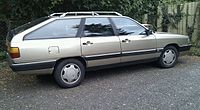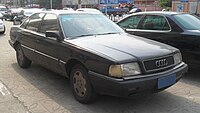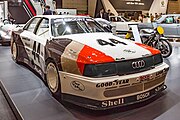Audi 200
| Audi 200 | |
|---|---|
| Production period: | 10 / 1979-07 / 1991 |
| Class : | upper middle class |
| Body versions : | Limousine , station wagon |
| Successor: | Audi V8 |
The Audi 200 was an upper mid- range vehicle offered by Audi between autumn 1979 and summer 1991 in two different model series and represented an upgraded variant of the largely identical Audi 100 .
The Audi 200 was only with five-cylinder - petrol engines available. The first model series, which was built until 1982, was only available as a four-door sedan with front-wheel drive, apart from a few station wagons produced in small series . The second series, produced from 1983 onwards, was also available as an Avant version and with all-wheel drive . Until the introduction of the Audi V8 with eight-cylinder engine in 1988, the Audi 200 was the top model in Audi's model range.
Audi 200 C2
| 1st generation | |
|---|---|
|
Audi 200 Turbo |
|
| Production period: | 10 / 1979-08 / 1982 |
| Body versions : | limousine |
| Engines: |
Petrol engines : 2.1 liters (100–125 kW) |
| Length: | 4694 mm |
| Width: | 1768 mm |
| Height: | 1389 mm |
| Wheelbase : | 2677 mm |
| Empty weight : | 1260 kg |
General
With the Type 43, Audi presented the first Audi 200 in October 1979. While the 2.1-liter five-cylinder engine (5E) was the largest available engine in the Audi 100 , this was the basic engine in the Audi 200. From February 1980, the Audi 200 5T was offered with a turbocharged unit and 125 kW (170 PS) (engine code WJ). The Audi 200 5T was unique because Audi initially only offered the turbocharged engine in this model. In the USA this model was sold as the Audi 5000 S Turbo .
Originally, a sporty version with a rotary engine was also planned, also with 125 kW (170 hp), of which a few pre-series vehicles were produced. However, the Wankel engine was quickly abandoned in the VW Group. One of these cars is in the Audi Museum in Ingolstadt.
While the Audi 100 was divided into various equipment variants, the Audi 200 basically had the most expensive equipment, that of the Audi 100 CD.
This contained, among other things, central locking, electric windows, a stereo cassette radio, velor seats and four frame headrests. Two “resting cushions” were supplied, which were covered with the velor of the seat covers. The Audi 200 5E was actually an Audi 100 CD 5E, albeit with a sportier appearance, which was characterized by different fabric designs in the interior and a harder suspension. The 5-hole wheel hubs with the 112 mm bolt circle, which are common at Audi today, were introduced in the Audi 200 in 1979.
The details differed quite a bit from the Audi 100. The side trim strips were arranged lower, wider and made of rubber, the bumpers were made of black plastic with an integrated carrier made of fiberglass-reinforced plastic and looked bulky. The front indicators were not next to the headlights, but in the bumper, and the twin headlights were taken from the Audi 5000 . A wide spoiler closed off the front at the bottom. This made the Audi 200 appear more impressive than the Audi 100.
The gearbox of the turbo version of the Audi 200 had a shorter gear ratio in the major gears than in the basic version of the Audi 200 5E. It also differed from the Audi 100 in terms of light alloy spoked wheels from the manufacturer Ronal and rear disc brakes.
The first Audi 200 was not offered as an Avant . A station wagon version of this model was produced in small series at the Artz company. This was also offered with all-wheel drive and the 147 kW engine from the Audi Quattro. In the Audi 200, a Bosch anti-lock braking system was available for the first time as an optional extra.
Production of the Audi 200 Type 43 was discontinued in August 1982.
Technical specifications
| model | Audi 200 5E | Audi 200 5T |
|---|---|---|
| Engine code | WC | WJ |
| Cubic capacity in cm 3 | 2144 | 2144 |
| cylinder | 5 | 5 |
| Performance in HP / kW | 136/100 | 170/125 |
| Mixture preparation | Bosch K-Jetronic | Bosch K-Jetronic with turbocharging |
| Dimensions L / W / H in mm | 4695/1768/1390 | |
| Tires | 205 / 60HR15 | |
| Weight in kg | 1260 | |
| V max in km / h (autom.) | 188 (183) | 202 (195) |
| 0–100 km / h in s (autom.) | 10.6 (12.5) | 8.6 (9.4) |
| construction time | 1980-1982 | 1980-1982 |
| Production number | 12,452 | 38,807 |
Audi 200 C3
| 2nd generation | |
|---|---|
|
Audi 200 quattro 20V (1989–1991) |
|
| Production period: | 06 / 1983-07 / 1991 |
| Body versions : | Limousine , station wagon |
| Engines: |
Otto engines : 2.1–2.3 liters (100–162 kW) |
| Length: | 4807 mm |
| Width: | 1814 mm |
| Height: | 1422 mm |
| Wheelbase : | 2687 mm |
| Empty weight : | 1260-1520 kg |
General
In September 1983 Audi presented a new 200, which in turn was based on the Audi 100 ( Type 44 ). From mid-1984 there was also an Avant version of the Audi 200, which was built until the end of 1990.
The naturally aspirated five-cylinder engines with a displacement of 2.1 liters and 100 kW (136 hp), 2.2 liters and 101 kW (137 hp) and finally a 2.3 liter with 100 kW (136 hp) are available. All other engines are five-cylinder turbo engines with a displacement of 2.1 and 2.2 liters and outputs between 121 and 162 kW.
With a drag coefficient (C w ) of 0.30, the Audi 100 Type 44 had a more aerodynamic design than most other vehicles of the time. New problems such as “interior heating” due to the flat inclined window panes were brought up and publicly discussed for the first time with this model.
However, the Audi 200 did not achieve the drag coefficient of the Audi 100 due to the modified add-on parts. Despite the identical body, it was measured with a C w value of 0.33.
Upon request, the Audi 200 was initially also available in a "government version" with the 98/100 kW five-cylinder petrol engine known from the Audi 100.
For a short period of time (from 1988 to 1990) more powerful engines were offered with an output of 140 kW (automatic only; engine code 2B) or 147 kW (engine code 1B).
There were manual five-speed transmissions in both front-wheel and four-wheel drive cars; the three-speed automatic transmission was only available in combination with front-wheel drive.
While the Audi 100 was divided into equipment classes until the revision at the beginning of 1988 (basic model without a black cover between the rear lights in the area of the license plate, CC, CS (sporty) and CD), the Audi 200 was initially only available with the most expensive equipment. Later there was the special model 200 Exclusiv with exhibited wheel arches and even more extensive equipment, including electrically adjustable leather seats and automatic air conditioning. Until the introduction of the Audi V8, the 200 was the most expensive series-built Audi. The Audi 200 exclusive cost 79,000 DM in 1987.
The front of the Audi 200 Type 44 has been upgraded compared to the Audi 100 with wider double headlights, standard fog lights, a large front spoiler in body color and a different bonnet. As in the previous model 200 Type 43, the front indicators are embedded in the bumper. The cover between the rear lights is continuous and in the same color as the rear lights.
Up until the facelift at the beginning of 1988, the Audi 200 had a different interior than the Audi 100 with a different dashboard, special door panels and lavishly padded seats.
At the beginning of 1988, the Audi 200 and 100 were given a visually and ergonomically better interior in key areas. In addition, in the last year of production, important safety features such as a driver airbag were available for an extra charge.
With the Audi 200 Type 44, the quattro permanent four-wheel drive was also offered in conjunction with a manual transmission for the first time .
From March 1989 the top model of the series was the Audi 200 quattro 20V with a turbocharged 2.2-liter five-cylinder engine with four valves per cylinder (engine code 3B), which is based on the engine of the Audi Quattro . The output of 162 kW (220 PS) ensures a top speed of 242 km / h (station wagon variant 238 km / h) and acceleration from 0 to 100 km / h in 6.6 seconds (station wagon variant 6.7 seconds ). This made the Audi 200 with this engine variant one of the fastest production sedans of the time (factory information). The FAZ's driving report said at the time:
“You have to search very high in the car rankings to find a similar impressively motorized sedan: 246 km / h top speed and 7.5 seconds from 0 to 100 km / h are values that only the most expensive BMW and Mercedes achieved, but can hardly be surpassed. "
Audi operated advertising for the Audi 200 in the form of product placement in films and series. In the ZDF series Die Schwarzwaldklinik , head physician Prof. Dr. Brinkmann an Audi 200, also in the James Bond film The Living Daylights , an Audi 200 was used in 1987.
The Audi 200 quattro Trans-Am , based on the Audi 200 C3, was the first factory racing car used by Audi for racetracks since the 1930s.
The Audi 200 Type 44 was the last Audi 200 offered in Germany; production ended in mid-1991.
The Audi 200 abroad
In China, the Audi 200 L (a long version especially for the Chinese market) from FAW-Volkswagen was only available from February 1996. Production of the model was discontinued in summer 1999.
| model | Displacement (cm³) | Engine code | power | comment | variant | construction time |
|---|---|---|---|---|---|---|
| 2.1 | 2144 | WC | 100 kW (136 hp) | limousine | 06 / 1983-07 / 1984 | |
| 2.1 Turbo | 2144 | KG | 134 kW (182 PS) | also with quattro | Limousine, Avant | 06 / 1983–01 / 1988 |
| 2.2 | 2226 | KU | 101 kW (137 hp) | limousine | 08 / 1984-07 / 1985 | |
| 2.2 turbo | 2226 | MC | 121 kW (165 hp) | also with quattro | Limousine, Avant | 08 / 1985-07 / 1991 |
| 2.2 turbo | 2226 | 2 B | 140 kW (190 hp) | only automatic | limousine | 02 / 1988-12 / 1990 |
| 2.2 turbo | 2226 | 1B | 147 kW (200 hp) | also with quattro | Limousine, Avant | 02 / 1988-12 / 1990 |
| 2.2 20V Turbo quattro | 2226 | 3B | 162 kW (220 PS) | Limousine, Avant | 03 / 1989-07 / 1991 |
Production figures for the Audi 200 20V
| year | limousine | Avant |
|---|---|---|
| 1987 | 5 | 3 |
| 1988 | 31 | 15th |
| 1989 | 1,972 | 647 |
| 1990 | 2,553 | 905 |
| 1991 | 206 | 46 |
| total | 4,767 | 1,616 |
According to the KBA, at least 521 vehicles with type code numbers of the type 200 C3 were registered as of January 1, 2015.
Audi V8 (Type 44 / 4C)
→ Main article: Audi V8
Parallel to the Audi 200, there was another variant of the Audi 100 from autumn 1988, the Audi V8 (D11), which was originally intended to be called the Audi 300 and was priced above the Audi 200.
Initially, it was offered exclusively with a V8 engine with a displacement of 3.6 liters and an output of 184 kW (250 hp), Quattro all-wheel drive and an automatic transmission, but this did not achieve the performance of the Audi 200 Quattro 20V.
A 4.2 liter (4172 cm³) V8 engine with an output of 206 kW (280 hp) was available from mid-1992.
With the Audi V8, the differences to the Audi 100 on the body were greater than those of the Audi 200. a. a completely redesigned front of the vehicle, a chassis with a wider track, flared wheel arches and modified bumpers. The rear doors and the side strips were also different from the Audi 200, as was the instrument cluster.
Audi wanted to market the V8 as an independent upper-class vehicle, but it could not hold its own against the Mercedes-Benz S-Class or the BMW 7-series, as it was still perceived as the Audi 100 despite the differences mentioned. The sales figures remained far below expectations despite expensive advertising measures. Production of the V8 ended in mid-1994. The V8 was replaced by the completely new, independent and significantly larger Audi A8 model.
Web links
- Information about the Audi 200 C2
- Friends of the Audi Type 44 eV - Association for the Audi 100/200 Type 44 / C3
- www.audi100-online.de - Audi 100/200 C3, 1982–1990
Individual evidence
- ↑ http://www.langzeitauto.de/de/motoren .
- ↑ Original brochure Audi 200 quattro 20V , 906 / 1195.26.00 from February 1989.
- ↑ Gerold Lingnau: The unexpected end of the three turbo-vices , in: Frankfurter Allgemeine Zeitung of December 5, 1989, No. 282, p. T3.
- ↑ Passenger car inventory on January 1, 2015 by manufacturer, trade name and selected features. (PDF) In: Statistische Mitteilungen des Kraftfahrt-Bundesamt FZ 2, January 1, 2015. Kraftfahrt-Bundesamt, July 2015, p. 11 , accessed on September 26, 2015 .









